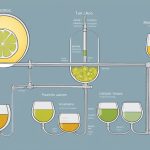As a beer enthusiast, I’ve always been fascinated by the complex flavors and aromas that make up this beloved beverage. But have you ever wondered what goes into making beer? Let’s take a deep dive into the basic ingredients that are essential for brewing beer.
Malted Grains
The foundation of any beer is malted grains, typically barley. These grains are processed by soaking them in water and allowing them to germinate. This activates enzymes that convert the starches in the grains into fermentable sugars. The grains are then dried and crushed to release these sugars, which will later be consumed by yeast during fermentation.
Hops
Hops are responsible for the bitterness and aroma in beer. These cone-shaped flowers contain compounds called alpha acids, which are released during the boiling process. This bitterness helps to balance the sweetness of the malted grains. Hops also add various flavors and aromas to the beer, ranging from citrusy and piney to floral and spicy.
Water
Water may seem like a basic ingredient, but it plays a crucial role in the brewing process. Different styles of beer require specific water profiles to achieve the desired flavor and mouthfeel. For example, the mineral content in water affects the perceived bitterness and overall character of the beer. Brewers often adjust their water composition to match the style they are brewing.
Yeast
Yeast is the magical ingredient that transforms the sugary wort into beer by consuming the sugars and producing alcohol and carbon dioxide. There are two main types of yeast used in beer brewing: ale yeast and lager yeast. Ale yeast ferments at warmer temperatures, resulting in fruity and complex flavors, while lager yeast ferments at cooler temperatures, producing a cleaner and crisper taste.
Personal Touches and Commentary
I find it fascinating how these simple ingredients can come together to create a beverage with such complexity and diversity. The wide variety of malts, hops, and yeast strains available to brewers allows for an endless array of beer styles and flavors.
As a homebrewer myself, I enjoy experimenting with different combinations of ingredients to create unique brews. Whether it’s adding specialty malts to enhance the caramel notes or dry hopping with tropical hops to create a burst of fruity aromas, there is always room for creativity in the brewing process.
One thing I love about beer is how it brings people together. It’s not just a drink; it’s a social lubricant that encourages conversations and connections. Exploring different beers and discussing their flavors with friends is an experience that never gets old.
Conclusion
So the next time you crack open a cold beer, take a moment to appreciate the craftsmanship and artistry that goes into its creation. From the malted grains that provide the backbone to the hops that add bitterness and aroma, each ingredient plays a vital role in shaping the character of the beer. Cheers to the basic ingredients that make beer so wonderfully diverse and enjoyable!







